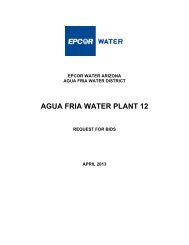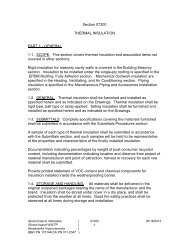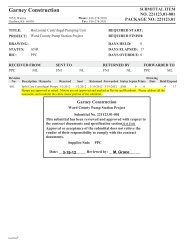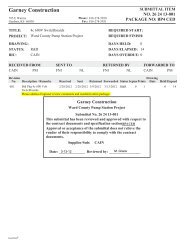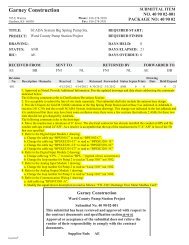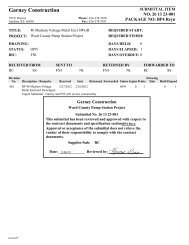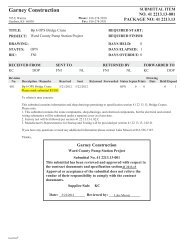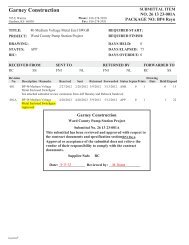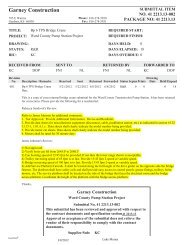33 12 16.26 - 001-A - Butterfly Valves - Garney Construction
33 12 16.26 - 001-A - Butterfly Valves - Garney Construction
33 12 16.26 - 001-A - Butterfly Valves - Garney Construction
You also want an ePaper? Increase the reach of your titles
YUMPU automatically turns print PDFs into web optimized ePapers that Google loves.
Design Details:<br />
Triton XR-70 <strong>Butterfly</strong> Valve<br />
1) Corrosion Resistant Shafts<br />
To prevent corrosion of a vital structural component,<br />
shafts are con struct ed of centerless ground ASTM A276<br />
type 304. This material is superior to car bon steel or<br />
similar materials that afford little protection against the<br />
harmful effects of cor ro sion. Pratt’s standard line consists<br />
of a two-piece, stub-type shaft keyed for the actuator<br />
connection.<br />
2) Packing and Packing Gland Assemblies<br />
Packing is self adjusting “V” type. The packing gland or<br />
shaft seal is uti lized only in the top trunnion of the valve<br />
body where the shaft protrudes for actuator connection.<br />
The packing as sem bly incorporates a nylon pack ing<br />
re tain er accompanied by several rings of packing. Other<br />
available packing gland ar range ments include water seals<br />
(lantern glands) for pos i tive and negative pressures, and<br />
reverse “V” type for vacuum ap pli ca tions. Where access<br />
to packing is required, open-type bonnets can be provid<br />
ed. When this option is specified, “V” type packing is<br />
held in place with a bronze retaining gland which is fastened<br />
to the valve trunnion with plated steel cap screws.<br />
3) Bearings<br />
Self-lubricating, sleeve-type bearings are used in both<br />
trun nions of the valve body. Bearings support the shaft<br />
and pro vide minimum friction during shaft rotation.<br />
Bear ing material is Teflon-lined with a special fi berglass<br />
back ing. This type of bearing offers electrical<br />
insulating qual i ties between the disc/shaft assembly<br />
and the valve body, thereby diminishing the effects of<br />
galvanic corrosion. In addition, its reduced co ef fi cient of<br />
friction requires far less torque than the metallic bear ing<br />
materials.<br />
4) Rubber Seat<br />
The multi-ridge surface of Pratt’s E-Lok seat seals a<br />
full 360˚ against a stainless steel spherical disc edge.<br />
Be cause of the laterally spaced grooves, rubber stress<br />
is sub stan tial ly reduced, resulting in less sealing torque.<br />
The grooved seat design, coupled with the wide spher i-<br />
cal ly shaped seating edge of the disc, also allows greater<br />
disc closure tolerance. Regardless of valve size, angular<br />
misposition of the disc can be 1˚ off center without<br />
leakage. The seat is mechanically retained by a unique<br />
ep oxy in jec tion process which moves the seat against the<br />
disc to conform to the exact radius of the disc with uniform<br />
con tact pressure. It is fully adjustable by local epoxy<br />
in jec tion and can be replaced in the field. As an option,<br />
valves may be pur chased with an ex ter nal in jec tion port<br />
which allows seat adjustment and repair to be performed<br />
with out re mov ing the valve or de w a ter ing the pipeline.<br />
For additional in for ma tion regarding the E-Lok seat, refer<br />
to the “E-Lok Seat Design” section of this brochure.<br />
5) Shaft Connection<br />
Disc-to-shaft connection is accomplished by<br />
conservative ly sized stainless steel or monel taper pins,<br />
threaded at one end and secured with lockwashers and<br />
nuts. On 24 inch valves, stainless steel dowel pins are<br />
used. Pratt’s through-pin design provides the tightest<br />
possible con nec tion between the shaft and disc.<br />
6) Valve Disc<br />
Pratt valve discs are constructed of the high est strengthto-weight<br />
ra tio materials available. On our 24 inch valve,<br />
the arch side of the disc is closed and the flat side is open,<br />
forming a slightly concave surface. On valves 30 inches<br />
and greater, a flow through disc design is em ployed to<br />
minimize line tur bu lence and lower head loss. The great er<br />
free flow area pro vides less pres sure drop in the full-open<br />
position than other disc shapes. For ad di tion al in for mation<br />
re gard ing Pratt’s flow through disc de sign, refer to<br />
“Flow through Design” section of this brochure.<br />
7) Valve Body<br />
The bodies of the XR-70 are constructed of heavy cast<br />
iron ASTM A<strong>12</strong>6. On flange end bod ies, flange drilling<br />
is provided in ac cor dance with ANSI B16.1 for cast iron<br />
flanges through 72 inches. Larger sizes where applicable<br />
per AWWA C207.<br />
8) Thrust Bearing Assembly<br />
The two-way thrust bearing is preset at the factory. On<br />
valves 30 inches and larger, the thrust bearing assembly<br />
consists of a stainless steel or monel stud fastened to<br />
the bottom of the valve shaft. The stud extends beyond<br />
the bottom cover. The thrust collar is threaded to the<br />
stud and pinned. On the 24 inch valve, the thrust collar<br />
is pinned to the shaft and fitted with bronze spacers. The<br />
bottom cover cap is then bolted to the bot tom cover and<br />
retains the thrust collar which, in turn, retains the position<br />
of the disc assembly. The cavity con tain ing the thrust<br />
collar is packed with grease providing lifetime lubrication<br />
of the thrust bearing assembly. The cap is fully gasketed<br />
to prevent leakage.<br />
Valve End Connection Options<br />
A wide range of valve end con nec tion options for the<br />
Pratt Triton XR-70 are available. See “Valve End Types<br />
and Dimensions” section for details.<br />
Actuation Options<br />
See “Actuation” section for Pratt actuators or refer to<br />
Pratt’s Actuator brochure for the many ac tu a tion op tions<br />
available for the Tri ton XR-70.<br />
Henry Pratt Company | 5



